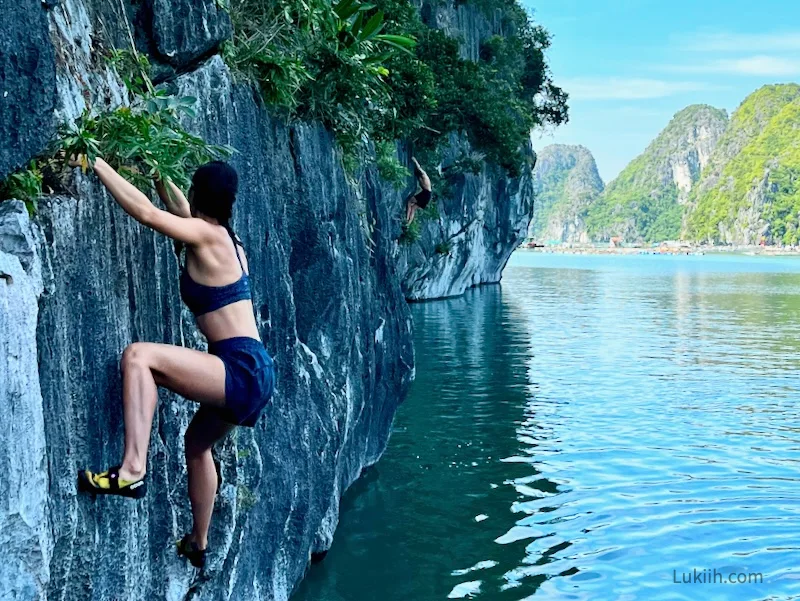Vietnam has several top roping locations, but deep water soloing, which is rock climbing above water without ropes, is only allowed in Lan Ha Bay, a section of Halong Bay. Using a clear travel rating system, I share what the experience is like—plus tips from my own trip.
Lists By Lukiih is readers-supported. When you buy with my affiliate link, I may earn a small commission. Thanks!
🍀 Lukiih’s Verdict
I highly recommend deep water soloing in Vietnam if you’re comfortable. It was one of my most unforgettable experiences.
- The limestone rock scenery is breathtaking, and the emerald water is warm and pleasant.
- You’re required to have a licensed guide as Halong Bay is a UNESCO-protected site, and Lan Ha Bay is an extension of it. The experience is affordable and includes snacks, transportation, a guide, and gear.
- Extensive preparation is required, as you need to book in advance, pack accordingly, and travel from Hanoi to reach the bay.
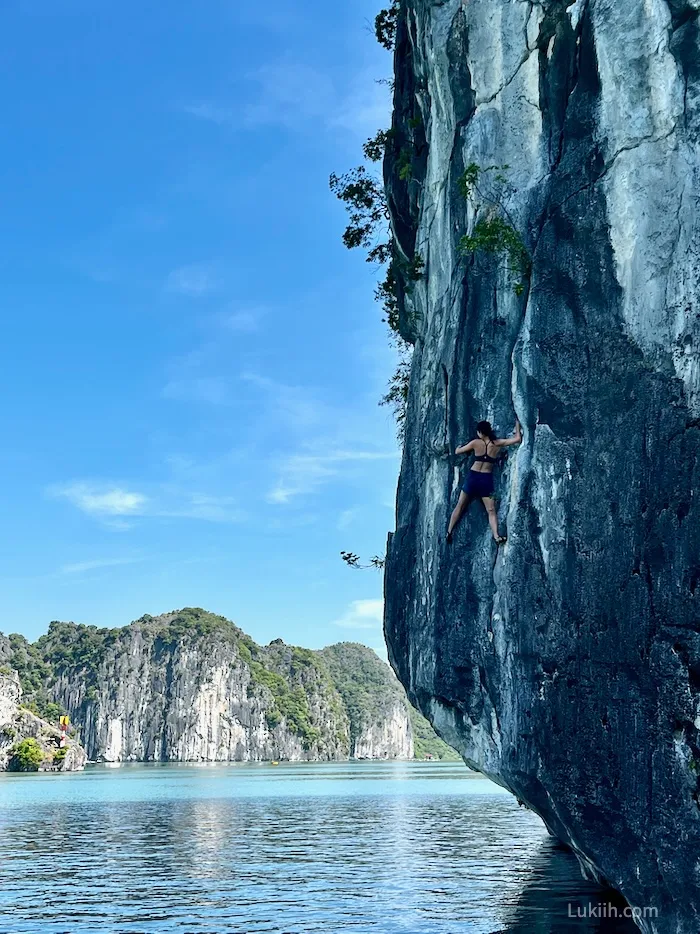
🇻🇳 Planning A Trip To Vietnam: 12 Practical Things To Know
🏆 Where Does It Rank?
Deep water soloing ranks as the #2 experience I had in Vietnam. Here’s how it compares to other things I did on my trip:
⛰️ 10 Epic Days in Vietnam: A Unique & Active Itinerary
✈️ About My Trip
For context on my review, here’s what to know about my trip:
- I finance my trips and don’t receive sponsorship; this review reflects my honest opinions.
- I deep water soloed in Vietnam in 2022, but this post has updated 2025 information.
- My Vietnam trip was in October when it was more crowded and expensive.
- Deep water soloing in Vietnam is a rare experience. Deep water soloing itself is niche, and very few locations in the world offer both safe, accessible cliffs and warm water — Lan Ha is one of them.
- The water is usually calm and warm compared to many other deep water soloing areas, making it a pleasant experience. Climbing up the limestone cliffs and taking in the surrounding views is epic and breathtaking.
Featuring over 200 routes, Lan Ha Bay is the only place to deep water solo in Vietnam. It’s an extension of the famous Ha Long Bay and also has top roping routes.
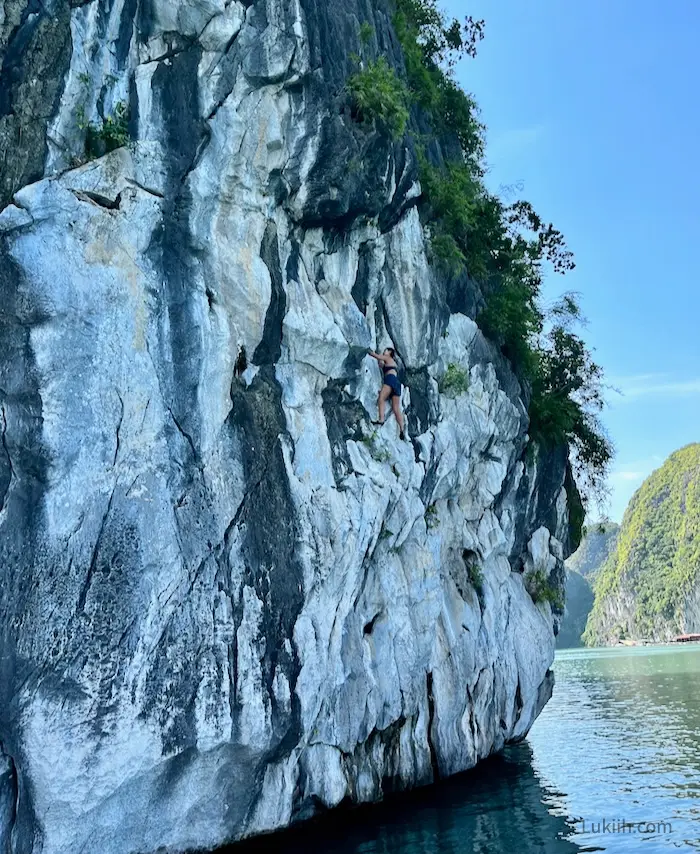
- Several other beautiful places offer deep water soloing worldwide, including Yangshuo in China, Kalymnos in Greece, and Sardinia in Italy. The mecca of deep water soloing is Mallorca, Spain, not Vietnam.
- I found deep water soloing in Vietnam extremely enjoyable. Different routes are available for all skill levels, so you won’t get bored climbing the same area.
- The water is warm and pleasant to jump into (you don’t have to worry about cold shock).
- The tour I took was a small, intimate group, so I got to know other climbers from around the world.
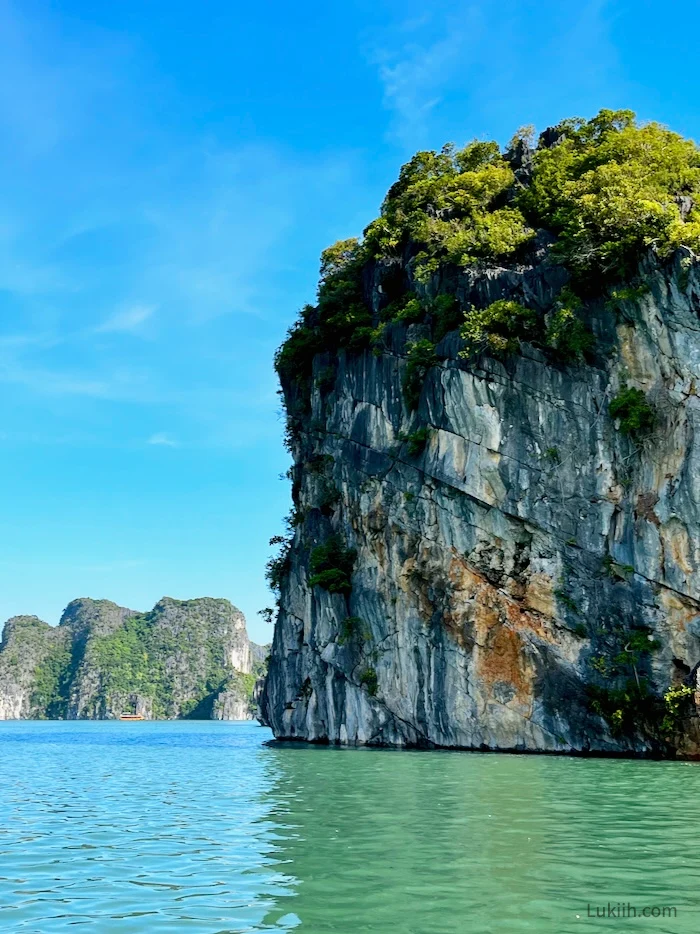
- Jumping off of anything above 15 feet was scary for me. Our group jumped from 10 to 25 feet high; I hit my maximum height at around 18 feet.
- For more experienced rock climbers, being required to go with a guide might feel less rewarding since you’re not free to explore the routes on your own.
Scroll down for risks associated with deep water soloing.
Deep water soloing in Lan Ha Bay requires a licensed guide, and hiring one costs between $50 and $80 for a half-day tour. The experience lasts about five hours and includes snacks, transportation, gear, and a guide.
I booked my half-day tour with the well-rated Cat Ba Climbing and paid $69. Langur’s Adventures, another tour company offering deep water solo guides in the area, charges $70.
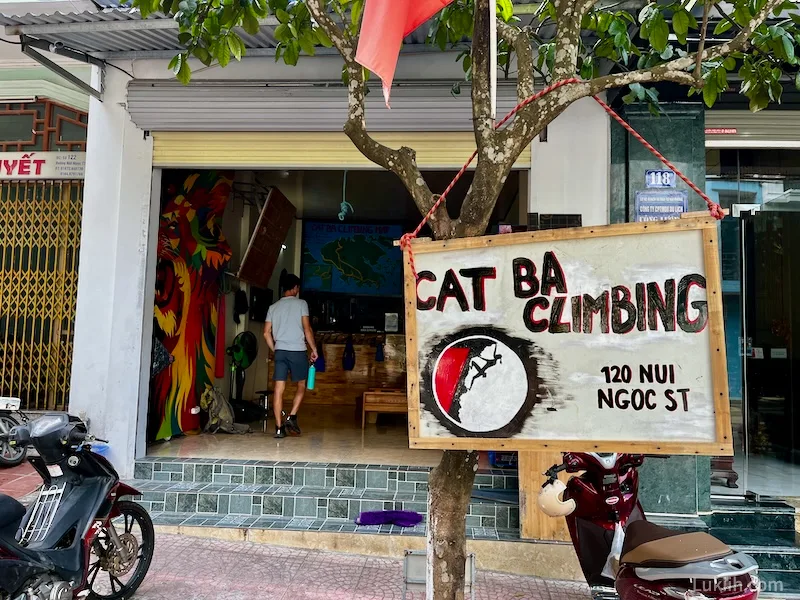
💰 My Vietnam Trip Cost: Budget Breakdown (2025)
- Although the tour groups welcome beginners, I suggest having some rock climbing skills and fitness to fully enjoy deep water soloing in Vietnam. Guides often say that “no experience is required,” but having some will help you enjoy it more as you can climb higher and see more of the landscape.
- Lan Ha Bay, which is right next to Cat Ba Island, is east of the capital city of Hanoi. To get to the bay, you can take a bus-ferry-bus from Hanoi to Cat Ba Island, like I did. I paid $28 round-trip. The journey takes 3 hours.
- Reserve a licensed guide a few days to a week in advance. If you’re staying in Cat Ba Island, book accommodations in advance. Your tour group will provide the necessary climbing gear, but you’ll also want to pack accordingly for jumping into the water.

How To Guide & Tips
Interested in deep water soloing in Vietnam after reading my review? Below is a practical how-to guide and firsthand tips.
Essential Tips
Deep water soloing (DWS) is a form of rock climbing without any ropes in which climbers fall into a deep body of water, usually a lake or the ocean (and sometimes, an artificial pool). Here are essential tips to know before trying it:
- 🧗♀️ Only a little rock climbing experience is needed – You don’t need to be a “good” or experienced climber. You need to be able to climb up nature rocks with good holds, so some basic experience is helpful.
Some climbing tours, like the one I did, require no rock climbing experience. This is only true if you go with experienced climbers who can identify beginner-friendly routes.
- 🏊 You should be comfortable swimming – You will be falling or jumping into the water, so you need to be comfortable swimming back to the boat.
- 👀 Always know where to jump – Rocks can hide under the water, so you can get severely or fatally injured if you don’t know which areas are safe to fall or jump into.
- 🦶 Hit feet first to break the water’s surface – You should hit the water like a pencil to not accidentally hurt your arms or punch yourself. Hitting the water can hurt when jumping from 15+ feet high. I had a slight bend in my knee when I jumped from 18 feet high, so my tailbone was a bit sore for four days.
Ideally, you should also have your feet parallel to the water and hit your heels first (not your toes pointed down). The idea is to break the water’s surface with a strong point of your foot.
- 💡 Always go with experienced climbers – For the above reasons, never go alone or with inexperienced people. You can either go with an organized group or with experienced people.
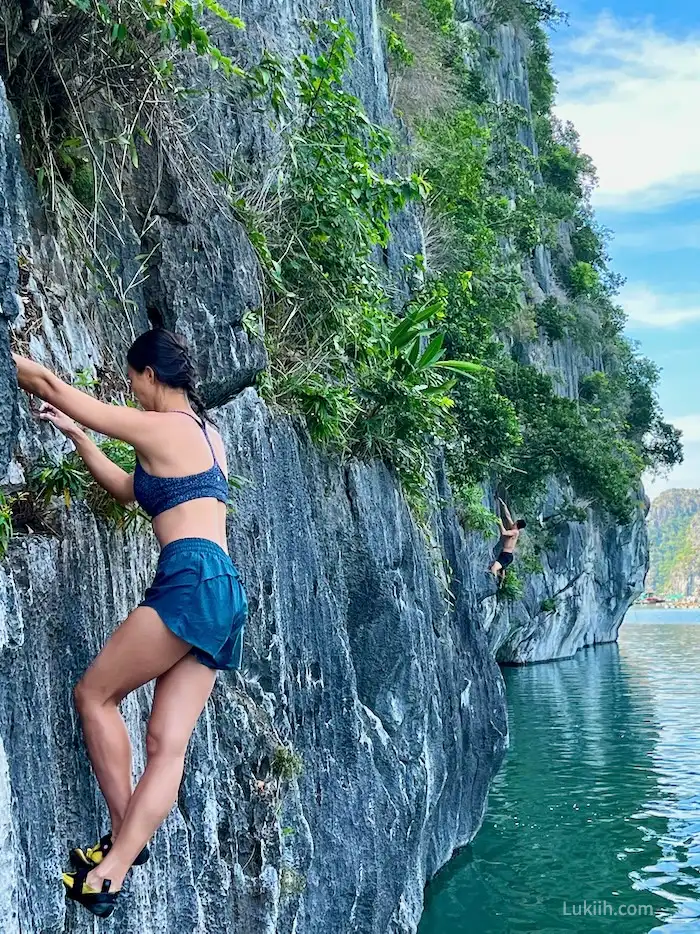
What To Expect
Here’s what to expect when you’re deep water soloing in Lan Ha Bay:
- The first practice climb and jump are not high – The guide will have you do a baby climb and practice the pencil technique for jumping about 10 feet high.
- There are different routes for varying climbers – The guides know several rocks to climb, each with several routes. The guide will match climbing routes to your experience level (e.g., my boat had V2 to V7 climbers, and even though we all went to the same rock, we didn’t climb the same routes).
- Only one to two climbers climb at a time – The boat will get close to the rock, you will get on it, and the guide will ensure you’re secure before the boat pulls away. Once the boat starts pulling away, you can start climbing. After you fall or jump into the water, you’ll swim back to the boat and climb up a small ladder.
- It’s okay if you get stuck or fall – If you’re on a route and unsure of what to do next, the guide has a laser pointer and can guide you along the route. They will also tell you the best way to fall if you can’t finish the route.
- The height of the jump can vary and be scary – Our group jumped from 10 to 25 feet high. If you’ve never jumped from over 15 feet high and you’re not an adrenaline junkie, it can be scary.
I struggled with jumping the most in my group, and my advice is to jump as soon as possible. The longer you think about it, the harder it becomes.
Itinerary
Here’s how a half-day deep water soloing tour in Lan Ha Bay breaks down:
| Timing | Itinerary |
|---|---|
| 8–8:30 am | Gear up and introduction – Arrive at the office and try climbing shoes to find the right size. You’ll take a short shuttle ride to the harbor when everyone is ready. |
| 8:30–9 am | Boat ride – You’ll cruise through the beautiful Lan Ha Bay, where you’ll get to enjoy the scenery and get to know your fellow climbers. |
| 9 am–1 pm | Deep water solo – You’ll spend about four hours rock climbing and jumping into the water. Before your first climb, the guide will walk through safety and techniques. The four hours will fly by. |
| 1–1:30 pm | Return to the office and pay – At the end of your session, you’ll be transported back to the Cat Ba office and pay for the tour in cash. |

What To Pack
The deep water solo tour group will provide climbing gear and light snacks. Here’s what you should bring and wear:
- Bathing suit or sports bra and shorts – You’ll want to wear a bathing suit that stays on when you hit the water. Wear something tight.
- Quick dry towel – You’ll need to dry yourself between climbs and at the end of the tour. I brought my regular-sized quick-dry towel, which worked great.
- Clothes you can quickly put on and take off – Depending on when you go and whether you’re in the shade, you might be cold between climbs.
- Sandals – You’ll be barefoot or in climbing shoes most of the time, but make sure you bring sandals for after the tour. I brought my Chacos.
- Sunscreen – You might want to bring sports sunscreen depending on the season and whether you’re in the shade. I recommend this water-resistant sunscreen.
- Extra snacks and water – The tour provided beers, non-alcoholic drinks, and fresh fruits, but bring extra snacks and water if you think you’ll need more sustenance. I brought my reusable water bottle, which kept my water cold.
Should You Bring Climbing Shoes?
If you’re considering bringing your own climbing shoes, here are some things to know:
- Tour groups often provide climbing shoes – But it’s good to double-check.
- Natural rocks cause wear and tear quickly – This is especially true in Vietnam, where you’ll be climbing limestone, which is particularly sharp.
- Rinse your shoes to avoid damage – If you jump into salt water, the salt can damage and erode the rubber over time, so rinse them afterward.
- It’s not that weird to climb with wet rental climbing shoes – No one loves wearing rental shoes or wet shoes, but deep water soloing should be thrilling enough that climbing in wet rental shoes won’t be your primary concern.
Vietnam Trip Planner 2025
Make planning easier with my flexible, research-backed travel planner—shaped by real experience. It has:
- Up-to-date travel info
- A well-curated itinerary
- Practical, firsthand insights & tips
- A simple budget tracker
- A starter packing list
- Fully customizable sections
Built in Notion, this is the tool I personally use to plan every trip. I genuinely love it and creating a Notion account is free.
Lists by Lukiih is a small site I fund myself. Downloading my trip planner is the best way to support me and keep it running—thanks!

Vietnam Travel Guides
- 🇻🇳 Planning A Trip To Vietnam: 12 Practical Things To Know
- ⛰️ 10 Epic Days in Vietnam: A Unique & Active Itinerary
- 💰 My Vietnam Trip Cost: Budget Breakdown (2025)
- 🍜 Hanoi Guide: 14 Great Things To Do, Eat and Skip
- 🏍️ Ha Giang Loop: Firsthand Review & Tips
- 🧗♀️ Deep Water Solo in Vietnam: Firsthand Review & Tips
- 🏮 Hoi An Guide: 11 Great Things To Do + 3-Day Itinerary
- 👗 My Hoi An Tailor Experience: Prices & What To Know
